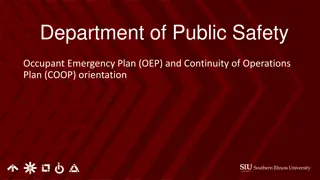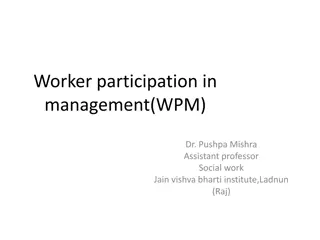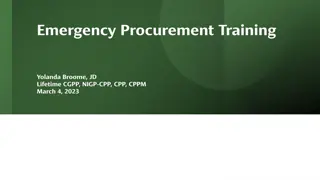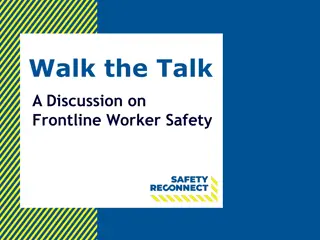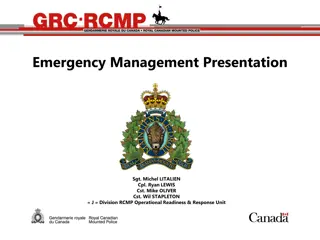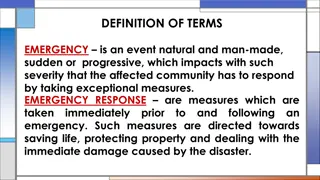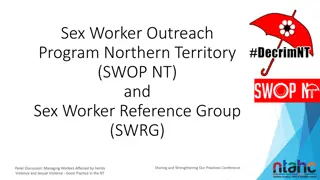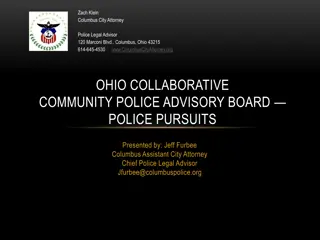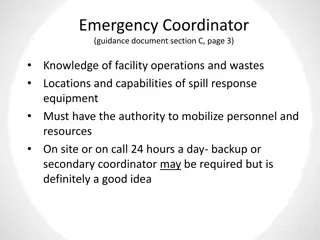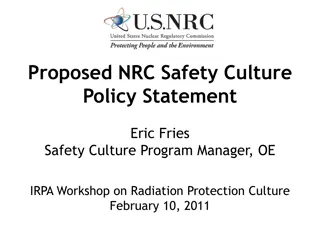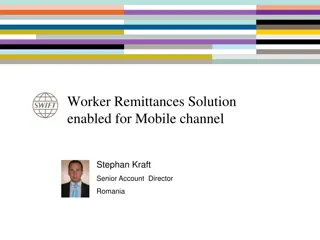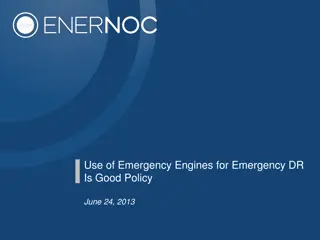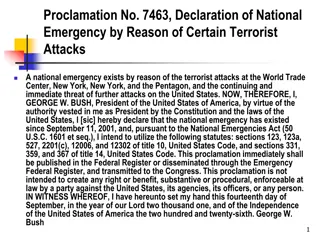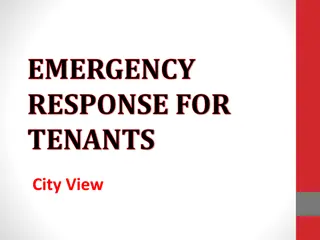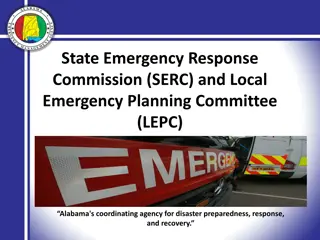Emergency Response Proposed Rule - Worker Safety and Health Conference
The Emergency Response Proposed Rule aims to update regulations for worker safety and health, expanding coverage to include technical search and rescue and emergency medical service entities. The rule proposes replacing the existing Fire Brigades standard with an Emergency Response standard. Federal agencies must align their occupational safety programs with OSHA standards, excluding certain activities covered by other OSHA regulations. The rule clarifies terms for coverage of Emergency Service Organizations and Workplace Emergency Response Teams.
Download Presentation

Please find below an Image/Link to download the presentation.
The content on the website is provided AS IS for your information and personal use only. It may not be sold, licensed, or shared on other websites without obtaining consent from the author. Download presentation by click this link. If you encounter any issues during the download, it is possible that the publisher has removed the file from their server.
E N D
Presentation Transcript
Emergency Response-Proposed Rule NRT Worker Safety and Health Technical Conference March 13-14, 2024
Presented by: Mark Hagemann Director Office of Safety Systems Directorate of Standards and Guidance Bill Hamilton Fire Protection Engineer Office of Safety Systems Directorate of Standards and Guidance
The BIG Picture OSHA is proposing to update by replacing existing 29 CFR 1910.156, Fire Brigades standard Standard would be called Emergency Response
Who Would be Covered by Emergency Response? Entities currently covered by 1910.156 (firefighting service), expanding to include entities that provide technical search & rescue, and emergency medical service. Firefighting, technical search & rescue, and emergency medical service responders covered by State Plan states.
Federal Agency OS&H Programs Federal agency OS&H programs must be consistent with OSHA standards, or agencies can develop their own standards for approval by the Secretary of Labor. Pursuant to section 19 of the OSH Act (29 U.S.C. 668) and Executive Order 12196, Federal agency occupational safety and health programs are established by each agency head and must be consistent with the standards promulgated under section 6 of the Act. Accordingly, Federal agencies must comply with all applicable section 6 standards unless an alternative standard is approved by the Secretary (see 29 CFR 1960.16 and 1960.17).
Exclusions The proposed rule does not apply to activities covered by other OSHA rules: HAZWOPER - 29 CFR 1910.120 (Proposal includes update for PPE to be consistent with NFPA 1990) Permit-Required Confined Spaces in General Industry 29 CFR 1910.146 It also does not apply to employees performing disaster site clean-up or recovery activities (i.e., After the emergency nature of the incident has ended)
Clarifying terms for coverage Emergency Service Organizations (ESO) Provide emergency service as a primary function of the organization. Firefighting Emergency Medical Service (EMS) Technical Search & Rescue Public and private entities.
Clarifying terms for coverage Workplace Emergency Response Teams (WERT). General industry (private entity) employers that provide: Firefighting, Emergency Medical Service, Technical Search & Rescue Workers perform emergency service as a collateral duty to regular job duties.
Why is 1910.156 Being Updated? Current 1910.156 was promulgated in 1980 with only minor revisions since then. Does not address the full range of hazards facing emergency responders. Lags behind changes in protective equipment performance, national consensus standards & industry practices.
Updated Standard Would More closely align with emergency response best practices established by the Federal Emergency Mgt Admin. (FEMA) National Response Framework (NRF); provides structure for incident response at local, regional and national levels. Nat l Incident Management System (NIMS); provides a template for management of incidents, regardless of size, scope or cause.
Steps Up to Now 2007 Published a Request For Information, ~85 responses; overwhelming recommendation to update Fire Brigades standard. 2014 Held two Stakeholder Meetings, ~50 participants, broad spectrum of emergency response community. Strong consensus favored OSHA proceeding with comprehensive rulemaking for emergency response workers. 2015 Convened a NACOSH Subcommittee. 2021 Small Business Regulatory Enforcement Fairness Act Pannel (SBREFA). Feb. 2024 Proposed Rule officially published.
NACOSH Subcommittee They functioned similarly to the negotiated rulemaking process; developed a draft standard. Subcommittee members had great influence over the content of the draft standard, ensuring fair and balanced participation. Draft standard based on, and consistent with NFPA consensus standards that are already in use by emergency response organizations. NACOSH recommended to the Secretary of Labor that the draft standard developed by the Subcommittee be used as a basis for rulemaking.
NACOSH Subcommittee Members 2015-2016 National Advisory Committee on Occupational Safety and Health (NACOSH) subcommittee of Subject Matter Experts: International Brotherhood of Teamsters (NACOSH member, Co-chair) British Petroleum (NACOSH member, Co-chair) International Association of Fire Fighters International Association of Fire Chiefs National Volunteer Fire Council National Fire Protection Association National Association of State EMS Officials U.S. Fire Administration National Fallen Firefighters Foundation International Union of Operating Engineers North America s Building Trade Unions National Institute for Occupational Safety and Health Arizona Division of Occupational Safety and Health (State Plan) Virginia Department of Labor and Industry (State Plan)
Regulatory Approach of the Proposed Rule Performance oriented Program standard (e.g. HAZWOPER). Requires organizations to establish a safety and health program based on the provisions in the proposed rule, called: Emergency Response Program (ERP). Primary focus on preparing for emergency incidents and routine aspects of emergency response. Relies heavily on concepts in NFPA standards that response organizations already use. Incorporates by reference NFPA standards for PPE. Requires training consistent with NFPA standards already in use.
Outline of the Federal Register Notice Background Legal Authority Issues & Questions Summary and Explanation of the Proposed Rule Preliminary Economic Analysis (Costs/Benefits) State Plan Requirements Regulatory Text
Outline of the Proposed Rule (a) Scope (b) Definitions (c) Organization of Workplace Emergency Response Teams, Establishment of Emerg. Resp. Program (d) Establishment of ERP by Emergency Service Organizations (e) Employee Participation (f) Risk Management Plan (g) Medical and Physical Requirements
Outline of the Proposed Rule (h) Training (i) Workplace Employer Facility Preparedness (j) Emergency Service Org. Facility Preparedness (k) Equipment and PPE (l) Vehicle Preparedness and Operation (m) Workplace Employer Pre-Incident Planning (n) Emergency Service Org. Pre-Incident Planning
Outline of the Proposed Rule (o) Incident Management System Development (p) Emergency Incident Operations (q) Standard Operating Procedures (r) Post-Incident Analysis (s) Program Evaluation (t) Severability (Legal-Provisions are separate and severable)
Preliminary Economic Analysis The rule is a significant regulatory action under section 3(f)(1) of E.0. 12866, as amended by E.0. 14094. The rule will affect 22,552 Emergency Service Organizations and Workplace Emergency Response Teams with 1,142,733 responders and team members. The ER proposal costs would be less than one percent of revenues to ESOs and WEREs as a whole. Preventing approximately 11,000 injuries and 61 fatalities annually, the net benefits of the proposal are expected to be $2.0 billion per year (three percent discount rate).
Opportunities for Public Comment Feb. 5, 2024 Official publication in Federal Register (90-day public written comment period begins). May 6, 2024 - Public written comment period closes. TBD Public hearing with ALJ TBD Post-hearing written comments TBD Post-hearing legal briefs
Rulemaking Webpage Emergency Response Rulemaking webpage https://www.osha.gov/emergency-response/rulemaking Includes links to: https://www.federalregister.gov/documents/2024/02/05/2 023-28203/emergency-response-standard https://www.osha.gov/laws-regs/rulemakingprocess https://www.regulations.gov/docket/OSHA-2007-0073 https://www.osha.gov/sites/default/files/ER_NPRM_Que stions_and_Issues.pdf
We need your help!! OSHA encourages everyone (individuals and organizations) to submit comments, questions, concerns and any supporting information and data. The more information we have to work with as we develop a final rule, the better the rule will be!


